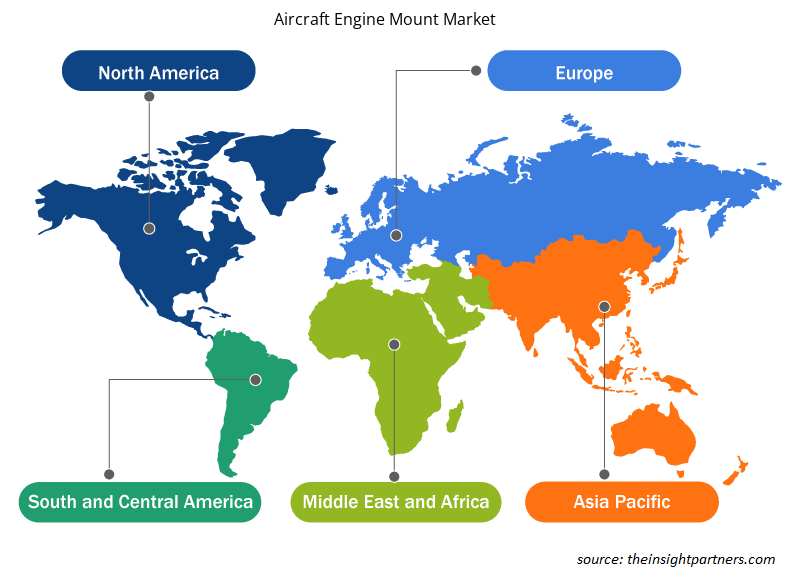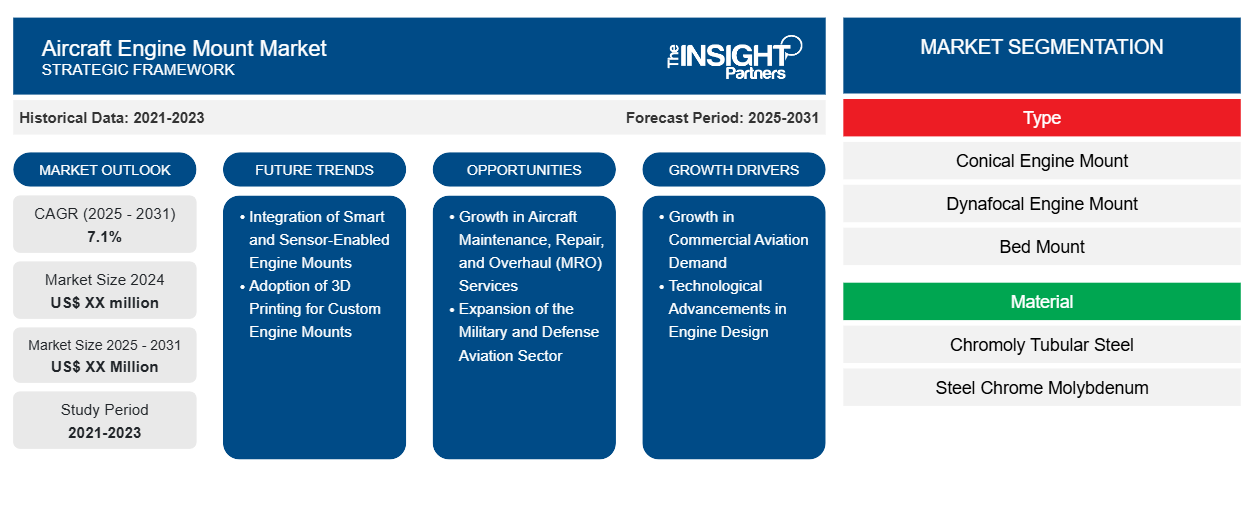Der Markt für Flugzeugmotorhalterungen wird voraussichtlich von 2023 bis 2031 eine durchschnittliche jährliche Wachstumsrate von 7,1 % verzeichnen, wobei die Marktgröße von XX Millionen US-Dollar im Jahr 2023 auf XX Millionen US-Dollar bis 2031 wachsen wird.
Der Markt ist nach Typ, Material und Anwendung segmentiert. Das Typsegment ist in konische Motorhalterung, dynamokale Motorhalterung und Betthalterung unterteilt. Basierend auf dem Material ist der Markt in Chromoly-Rohrstahl und Chrom-Molybdän-Stahl segmentiert. Basierend auf der Anwendung ist der Markt in Verkehrsflugzeuge und Flugzeuge der allgemeinen Luftfahrt segmentiert.
Zweck des Berichts
Der Bericht „Aircraft Engine Mount Market“ von The Insight Partners zielt darauf ab, die aktuelle Situation und das zukünftige Wachstum sowie die wichtigsten treibenden Faktoren, Herausforderungen und Chancen zu beschreiben. Dies wird verschiedenen Geschäftspartnern Einblicke geben, wie zum Beispiel:
- Technologieanbieter/-hersteller: Um die sich entwickelnde Marktdynamik zu verstehen und die potenziellen Wachstumschancen zu kennen, damit sie fundierte strategische Entscheidungen treffen können.
- Investoren: Durchführung einer umfassenden Trendanalyse hinsichtlich der Marktwachstumsrate, der finanziellen Marktprognosen und der Chancen entlang der Wertschöpfungskette.
- Regulierungsbehörden: Zur Regulierung von Richtlinien und Überwachungsaktivitäten auf dem Markt mit dem Ziel, Missbrauch zu minimieren, das Vertrauen der Anleger zu bewahren und die Integrität und Stabilität des Marktes aufrechtzuerhalten.
Marktsegmentierung für Flugzeugmotorhalterungen
Typ
- Konische Motorhalterung
- Dynafocal Motorhalterung
- Betthalterung
Material
- Chromoly-Stahlrohr
- Stahl Chrom Molybdän
Anwendung
- Verkehrsflugzeuge
- Flugzeuge der Allgemeinen Luftfahrt
Geographie
- Nordamerika
- Europa
- Asien-Pazifik
- Süd- und Mittelamerika
- Naher Osten und Afrika
Geographie
- Nordamerika
- Europa
- Asien-Pazifik
- Süd- und Mittelamerika
- Naher Osten und Afrika
Passen Sie diesen Bericht Ihren Anforderungen an
Sie erhalten kostenlos individuelle Anpassungen an jedem Bericht, einschließlich Teilen dieses Berichts oder einer Analyse auf Länderebene, eines Excel-Datenpakets sowie tolle Angebote und Rabatte für Start-ups und Universitäten.
- Holen Sie sich die wichtigsten Markttrends aus diesem Bericht.Dieses KOSTENLOSE Beispiel umfasst eine Datenanalyse von Markttrends bis hin zu Schätzungen und Prognosen.
Wachstumstreiber auf dem Markt für Flugzeugtriebwerkshalterungen
- Nachfragewachstum in der kommerziellen Luftfahrt: Die steigende Nachfrage nach Flugreisen und die damit einhergehende Ausweitung kommerzieller Flotten sind ein Haupttreiber für den Markt für Flugzeugmotoraufhängungen. Da Fluggesellschaften ihre Flotten weiter modernisieren und neue, treibstoffeffizientere Flugzeuge einführen, ist der Bedarf an Motoraufhängungen, die größere, leistungsstärkere Motoren tragen können, stark gestiegen. Flugzeughersteller wie Boeing und Airbus führen neue Modelle wie die Boeing 737 MAX und den Airbus A320neo ein, die mit fortschrittlichen Motoren ausgestattet sind, die den Treibstoffverbrauch senken und die Leistung verbessern sollen. Diese neuen Motortechnologien erfordern anspruchsvolle und langlebige Motoraufhängungssysteme, was die Nachfrage nach Motoraufhängungen im kommerziellen Luftfahrtsektor steigert.
- Technologische Fortschritte im Triebwerksdesign: Da Flugzeugtriebwerke immer leistungsstärker, effizienter und technologisch fortschrittlicher werden, besteht ein wachsender Bedarf an innovativen Lösungen zur Triebwerksaufhängung. Moderne Turbofan-Triebwerke sind leichter und kraftstoffeffizienter ausgelegt, ihre Leistung und Zuverlässigkeit hängen jedoch weiterhin von der Qualität und dem Design der Triebwerksaufhängungen ab. Diese Aufhängungen müssen den zunehmenden Vibrationen, der Wärmeausdehnung und den strukturellen Belastungen standhalten, die mit leistungsstärkeren Triebwerken einhergehen. Innovationen bei Materialien wie leichten Verbundwerkstoffen und modernen Legierungen haben in Kombination mit neuen Aufhängungstechniken Möglichkeiten zur Entwicklung effizienterer, langlebigerer und leichterer Triebwerksaufhängungen geschaffen. Diese Entwicklungen werden den Markt voraussichtlich weiter vorantreiben, da sich die Hersteller auf eine verbesserte Triebwerksintegration konzentrieren.
Zukünftige Trends auf dem Markt für Flugzeugmotorhalterungen
- Integration intelligenter und sensorgestützter Motoraufhängungen: Zukünftige Flugzeugmotoraufhängungen können über integrierte Sensoren und intelligente Technologien verfügen, um den Zustand und die Leistung des Motors und der Aufhängung selbst in Echtzeit zu überwachen. Diese „intelligenten“ Motoraufhängungen könnten wertvolle Daten zu Vibrationspegeln, Temperaturschwankungen, Belastungen und potenziellen Ausfallpunkten liefern, Frühwarnzeichen bieten und eine vorausschauende Wartung ermöglichen. Solche Technologien können die Betriebssicherheit und Lebensdauer von Flugzeugmotoren erheblich verbessern und bieten Herstellern die Möglichkeit, Innovationen mit sensorintegrierten Aufhängungen einzuführen, die Echtzeiteinblicke in die Leistung bieten.
- Einführung des 3D-Drucks für kundenspezifische Motoraufhängungen: Der 3D-Druck bzw. die additive Fertigung wird voraussichtlich eine transformative Rolle auf dem Markt für Flugzeugmotoraufhängungen spielen. Diese Technologie ermöglicht die Herstellung leichter, komplexer Designs, die mit herkömmlichen Fertigungsmethoden nicht leicht zu erreichen sind. In Zukunft könnte der 3D-Druck verwendet werden, um kundenspezifische Motoraufhängungen mit optimierten Formen, Materialien und Gewichtsprofilen herzustellen, die auf bestimmte Flugzeugtypen oder Motoren zugeschnitten sind. Dies könnte Materialabfall reduzieren, den Produktionsprozess rationalisieren und erhebliche Kosteneinsparungen für Hersteller und Fluggesellschaften bieten. Darüber hinaus könnten 3D-gedruckte Halterungen ein schnelles Prototyping ermöglichen und so die Entwicklung und Erprobung neuer Motoraufhängungslösungen beschleunigen.
Marktchancen für Flugzeugmotorhalterungen
- Wachstum bei Wartungs-, Reparatur- und Überholungsdiensten (MRO) für Flugzeuge: Der MRO-Sektor (Wartung, Reparatur und Überholung) spielt eine bedeutende Rolle auf dem Markt für Flugzeugmotorlager, insbesondere im Hinblick auf Ersatz und Reparaturen. Da kommerzielle und militärische Flugzeugflotten über längere Zeiträume hinweg in Betrieb bleiben, wird die Nachfrage nach MRO-Diensten steigen. Motorlager, die durch ständige Vibrationen und mechanische Belastungen Verschleiß ausgesetzt sind, müssen regelmäßig ersetzt oder gewartet werden. Die steigende Zahl der weltweit in Betrieb befindlichen Flugzeuge sowie die längere Nutzungsdauer älterer Flotten werden zu einer stetigen Nachfrage nach Motorlagern im Aftermarket-MRO-Sektor beitragen.
- Expansion des Militär- und Verteidigungsluftfahrtsektors: Die Militär- und Verteidigungsluftfahrtsektoren sind auch wichtige Treiber für den Markt für Flugzeugmotorhalterungen. Militärflugzeuge, darunter Kampfjets, Frachtflugzeuge und unbemannte Luftfahrzeuge (UAVs), benötigen robuste Motorhalterungssysteme, um den hohen Belastungen und harten Bedingungen standzuhalten, die häufig während Kampfeinsätzen und anderen Missionen auftreten. Da die Länder ihre Verteidigungsausgaben erhöhen und ihre Flotten mit modernen Kampfflugzeugen modernisieren, besteht weiterhin Bedarf an speziellen Motorhalterungen, die extremen Temperaturen, Hochgeschwindigkeitsoperationen und turbulenten Umgebungen standhalten. Die Nachfrage des Militärs nach leistungsstarken, maßgeschneiderten Motorhalterungen wird zum Wachstum des Marktes beitragen, insbesondere bei der Entwicklung von Kampfjets der nächsten Generation und modernen UAVs.
Regionale Einblicke in den Markt für Flugzeugmotorhalterungen
Die regionalen Trends und Faktoren, die den Markt für Flugzeugmotorlager im Prognosezeitraum beeinflussen, wurden von den Analysten von Insight Partners ausführlich erläutert. In diesem Abschnitt werden auch die Marktsegmente und die Geografie für Flugzeugmotorlager in Nordamerika, Europa, im asiatisch-pazifischen Raum, im Nahen Osten und Afrika sowie in Süd- und Mittelamerika erörtert.

- Erhalten Sie regionale Daten zum Markt für Flugzeugmotorlager
Umfang des Marktberichts über Flugzeugmotorhalterungen
| Berichtsattribut | Details |
|---|---|
| Marktgröße im Jahr 2023 | XX Millionen US-Dollar |
| Marktgröße bis 2031 | XX Millionen US-Dollar |
| Globale CAGR (2023 - 2031) | 7,1 % |
| Historische Daten | 2021-2022 |
| Prognosezeitraum | 2024–2031 |
| Abgedeckte Segmente | Nach Typ
|
| Abgedeckte Regionen und Länder | Nordamerika
|
| Marktführer und wichtige Unternehmensprofile |
|
Marktteilnehmerdichte für Flugzeugtriebwerksaufhängungen: Auswirkungen auf die Geschäftsdynamik verstehen
Der Markt für Flugzeugmotorhalterungen wächst rasant, angetrieben durch die steigende Endverbrauchernachfrage aufgrund von Faktoren wie sich entwickelnden Verbraucherpräferenzen, technologischen Fortschritten und einem größeren Bewusstsein für die Vorteile des Produkts. Mit steigender Nachfrage erweitern Unternehmen ihr Angebot, entwickeln Innovationen, um die Bedürfnisse der Verbraucher zu erfüllen, und nutzen neue Trends, was das Marktwachstum weiter ankurbelt.
Die Marktteilnehmerdichte bezieht sich auf die Verteilung der Firmen oder Unternehmen, die in einem bestimmten Markt oder einer bestimmten Branche tätig sind. Sie gibt an, wie viele Wettbewerber (Marktteilnehmer) in einem bestimmten Marktraum im Verhältnis zu seiner Größe oder seinem gesamten Marktwert präsent sind.
Die wichtigsten auf dem Markt für Flugzeugmotorhalterungen tätigen Unternehmen sind:
- Acorn Schweißen
- Cadence Luft- und Raumfahrt
- Continental Luft- und Raumfahrttechnologien
- EPI Inc.
- Honda Aircraft Company
Haftungsausschluss : Die oben aufgeführten Unternehmen sind nicht in einer bestimmten Reihenfolge aufgeführt.

- Überblick über die wichtigsten Akteure auf dem Markt für Flugzeugmotorhalterungen
Wichtige Verkaufsargumente
- Umfassende Abdeckung: Der Bericht deckt die Analyse von Produkten, Dienstleistungen, Typen und Endbenutzern des Marktes für Flugzeugmotorhalterungen umfassend ab und bietet einen ganzheitlichen Überblick.
- Expertenanalyse: Der Bericht basiert auf dem umfassenden Verständnis von Branchenexperten und Analysten.
- Aktuelle Informationen: Der Bericht stellt durch die Abdeckung aktueller Informationen und Datentrends Geschäftsrelevanz sicher.
- Anpassungsoptionen: Dieser Bericht kann angepasst werden, um spezifische Kundenanforderungen zu erfüllen und die Geschäftsstrategien optimal anzupassen.
Der Forschungsbericht zum Markt für Flugzeugmotorhalterungen kann daher dabei helfen, die Branchensituation und Wachstumsaussichten zu entschlüsseln und zu verstehen. Obwohl es einige berechtigte Bedenken geben kann, überwiegen die allgemeinen Vorteile dieses Berichts tendenziell die Nachteile.
- Historische Analyse (2 Jahre), Basisjahr, Prognose (7 Jahre) mit CAGR
- PEST- und SWOT-Analyse
- Marktgröße Wert/Volumen – Global, Regional, Land
- Branchen- und Wettbewerbslandschaft
- Excel-Datensatz
Aktuelle Berichte
Erfahrungsberichte
Grund zum Kauf
- Fundierte Entscheidungsfindung
- Marktdynamik verstehen
- Wettbewerbsanalyse
- Kundeneinblicke
- Marktprognosen
- Risikominimierung
- Strategische Planung
- Investitionsbegründung
- Identifizierung neuer Märkte
- Verbesserung von Marketingstrategien
- Steigerung der Betriebseffizienz
- Anpassung an regulatorische Trends























 Kostenlose Probe anfordern für - Markt für Flugzeugmotorhalterungen
Kostenlose Probe anfordern für - Markt für Flugzeugmotorhalterungen